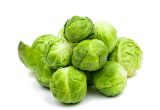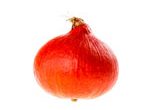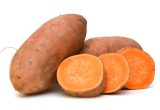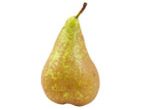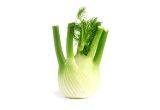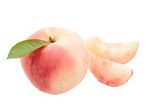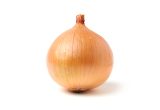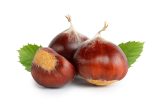Prickly pear

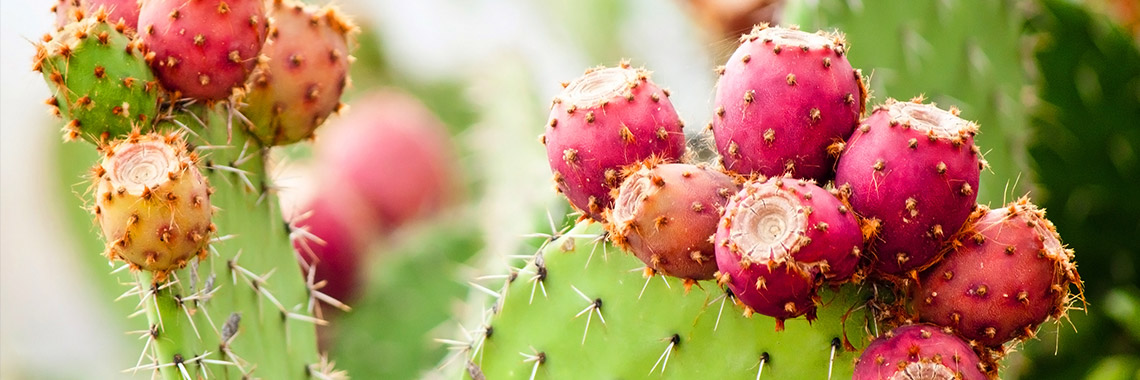
Description
- The prickly pear (Opuntia ficus-indica) belongs to the Cactaceae family.
- This plant grows in the wild in arid and semi-arid regions (Ennouri, 2014).
- It is a rapidly growing plant in Tunisia (Ennouri, 2014), but it is also widely present in Mexico, North and South America, as well as in Africa, Australia and the Mediterranean region in general (Hernandez-Urbiola, 2011).
PHYSICAL CHARACTERISTICS
- The fruit of the prickly pear is also called the cactus pear (Enouri, 2014) or nopal (Hernandez-Urbiola, 2011). The fruit contains many seeds.
- Betalains present in the skin and pulp of prickly pear are the pigments that give it its colour, ranging from yellow to purple (Khatabi, 2016).
- A Spanish team characterised the volatile profiles of the pulp of six prickly pear cultivars (NT, NE, NO, NA, FR, and ORI). A total of 35 compounds were identified, with aldehydes, alcohols and terpenes being the predominant families. Esters, ketones, linear hydrocarbons and terpenoids were also found (Andreu-Coll, 2020).
- Prickly pear is characterised by a “sweet” and “bitter” taste (Ochoa-Velasco, 2016; Nunes, 2017).
COMPOSITION CHARACTERISTICS (excluding macronutrients, vitamins and minerals)
- Plants of the Opuntia genus exhibit health-promoting properties resulting mainly from their high content of antioxidants (flavonoids, ascorbate), pigments (carotenoids, betalains) and phenolic acids (Del Socorro, 2017).
- Containing notable amounts of phenolic compounds with antioxidant properties but also nutrients, fibre and minerals, prickly pear is said to be beneficial in fighting atherosclerosis, diabetes, indigestion, inflammation and other immune-related symptoms (Jeong, 2018).
- The polyphenols and betalains contained in prickly pear give it its antioxidant properties. However, its polyphenol content reportedly depends on the variety: in particular, red prickly pear is thought to have a higher polyphenol content than yellow prickly pear (Khatabi, 2016).
- Betalains, consisting of betacyanins and betaxanthins, are reported to be beneficial in diseases related to oxidative stress, inflammation and dyslipidemia, such as artery stenosis, atherosclerosis, hypertension and cancer (Rahimi, 2019).
- Prickly pear is also reported to exhibit estrogenic activities1 due to the presence of flavonoid phytoestrogens such as isorhamnetin, kaempferol and quercetin (Jeong, 2018).
- At the seed level, extensive analysis revealed the presence of calcium (471.2 mg/kg), potassium (532.7 mg/kg), magnesium (117.3 mg/kg) and phosphorus (1627.5 mg/kg) (Özcan, 2011).
RAW
The following values are approximate and depend on variety, season, ripeness, cultivation conditions, etc.
Prickly pear is low in energy* because it provides an average of 36.80 calories (kcal) per 100 g, i.e. 154 kJ. A prickly pear weighs on average 50 to 400 g depending on the size, which corresponds to an energy intake ranging from 18.40 to 147.20 kcal.
COMPOSITION TABLES
For each nutrient, the tables provide information on the content, minimum and maximum values, as well as the percentage of the Dietary Reference Values (DRVs) for 100 g net of prickly pear, pulp and seeds, raw.
Regulation (EC) No 1924/2006 of the European Parliament and of the Council of 20 December 2006 on nutrition and health claims made on foods.
MACRONUTRIENTS
| Constituent (g) | Average content |
Min-Max per 100g |
DRV% |
|---|---|---|---|
| Water | 88,4 | 87,60 - 89,20 | - |
| Fibers | 4,45 | 3,60 - 5,30 | - |
| Carbohydrates | 6 | - | 2,31 |
| Sugars | 1,02 | - | 1,13 |
| Lipids | 0,31 | 0,11 - 0,50 | 0,44 |
| Saturated fat | < 0,01 | - | 0,05 |
| Protein | 0,37 | 0,12 - 0,63 | 0,74 |
| Constituent (g) | Amount | Min-Max | DRV% |
|---|---|---|---|
| Water | Ciqual 2020 | - | - |
| Fibers | Ciqual 2020 | - | - |
| Carbohydrates | Ciqual 2020 | - | Règlement (UE) N°1169/2011 du parlement Européen et du conseil du 25 octobre 2011 |
| Sugars | Ciqual 2020 | - | Règlement (UE) N°1169/2011 du parlement Européen et du conseil du 25 octobre 2011 |
| Lipids | Ciqual 2020 | - | Règlement (UE) N°1169/2011 du parlement Européen et du conseil du 25 octobre 2011 |
| Saturated fat | Ciqual 2020 | - | Règlement (UE) N°1169/2011 du parlement Européen et du conseil du 25 octobre 2011 |
| Protein | Ciqual 2020 | - | Règlement (UE) N°1169/2011 du parlement Européen et du conseil du 25 octobre 2011 |
Zoom on carbohydrates
- The prickly pear contains a lower amount of carbohydrates (6 g per 100 g) than the average quantity found in fresh fruit: 11.31 g per 100 g approximately.
- The prickly pear is low in sugar* (1.02 g per 100 g) as it contains no more than 5 g per 100 g.
Zoom on fibres
- The prickly pear is a source of fibre*, as it provides more than 3 g per 100 g, i.e. 4.45 g.
- This amount of fibre is higher than the average content found in fresh fruit (2.77 g per 100 g).
Zoom on proteins
- The protein content of prickly pear (0.37 g per 100 g) is lower than the average amount in fresh fruit: 0.93 g per 100 g.
Zoom on lipids
- Its fat content (0.31 g per 100 g) is lower than the average amount found in fresh fruit: 0.56 g per 100 g.
- The prickly pear is fat-free* as it contains less than 0.5 g of fat per 100 g.
Regulation (EC) No 1924/2006 of the European Parliament and of the Council of 20 December 2006 on nutrition and health claims made on foods.
MINERALS AND TRACE ELEMENTS
| Constituent | Average content |
Min-Max per 100g |
DRV% |
|---|---|---|---|
| Calcium (mg) | 118 | 56 - 180 | 14,75 |
| Chloride (mg) | - | - | - |
| Copper (mg) | 0,019 | - | 1,90 |
| Iron (mg) | 0,25 | 0,20 - 0,30 | 1,79 |
| Iodine (µg) | 1,50 | - | 1 |
| Magnesium (mg) | 77 | 69 - 85 | 20,53 |
| Manganese (mg) | 0,58 | - | 29 |
| Phosphorus (mg) | 17,50 | 11 - 24 | 2,50 |
| Potassium (mg) | 175 | 130 - 220 | 8,75 |
| Selenium (µg) | - | - | - |
| Sodium (mg) | 4,50 | 4 - 5 | - |
| Zinc (mg) | 0,14 | - | 1,40 |
| Constituent | Amount | Min-Max | DRV% |
|---|---|---|---|
| Calcium (mg) | Ciqual 2020 | - | Règlement (UE) N°1169/2011 du parlement Européen et du conseil du 25 octobre 2011 |
| Chloride (mg) | Ciqual 2020 | - | Règlement (UE) N°1169/2011 du parlement Européen, et du conseil du 25 octobre 2011 |
| Copper (mg) | Ciqual 2020 | - | Règlement (UE) N°1169/2011 du parlement Européen et du conseil du 25 octobre 2011 |
| Iron (mg) | Ciqual 2020 | - | Règlement (UE) N°1169/2011 du parlement Européen et du conseil du 25 octobre 2011 |
| Iodine (µg) | Ciqual 2020 | - | Règlement (UE) N°1169/2011 du parlement Européen et du conseil du 25 octobre 2011 |
| Magnesium (mg) | Ciqual 2020 | - | Règlement (UE) N°1169/2011 du parlement Européen et du conseil du 25 octobre 2011 |
| Manganese (mg) | Ciqual 2020 | - | Règlement (UE) N°1169/2011 du parlement Européen et du conseil du 25 octobre 2011 |
| Phosphorus (mg) | Ciqual 2020 | - | Règlement (UE) N°1169/2011 du parlement Européen et du conseil du 25 octobre 2011 |
| Potassium (mg) | Ciqual 2020 | - | Règlement (UE) N°1169/2011 du parlement Européen et du conseil du 25 octobre 2011 |
| Selenium (µg) | Ciqual 2020 | - | Règlement (UE) N°1169/2011 du parlement Européen et du conseil du 25 octobre 2011 |
| Sodium (mg) | Ciqual 2020 | - | - |
| Zinc (mg) | Ciqual 2020 | - | Règlement (UE) N°1169/2011 du parlement Européen et du conseil du 25 octobre 2011 |
Zoom on minerals and trace elements
- The prickly pear is a source of:
- manganese, as it provides the equivalent of 29% of DRVs, i.e. 0.58 mg per 100 g;
- magnesium, as it provides the equivalent of 20.53% of DRVs, i.e. 77 mg per 100 g. According to the Ciqual 2020 table, the prickly pear is one of the fruits with the highest magnesium content.
- The calcium content of the prickly pear is also noteworthy as it represents 118 mg per 100 g, which corresponds to 14.75% of DRVs. Moreover, it is one of the fruits that contains the most calcium (Ciqual 2020 table).
- The other minerals and trace elements are present in quantities representing less than 9% of DRVs.
VITAMINS
| Constituent | Average content |
Min-Max per 100g |
DRV% |
|---|---|---|---|
| Provitamin A Beta-carotene (µg) | 60 | - | - |
| Vitamin A equivalent (µg) | 10 | - | 1,25 |
| Vitamin B1 (mg) | 0,011 | 0,008 - 0,014 | 1 |
| Vitamin B2 (mg) | 0,046 | 0,032 - 0,06 | 3,29 |
| Vitamin B3 (mg) | 0,38 | 0,29 - 0,46 | 2,38 |
| Vitamin B5 (mg) | - | - | - |
| Vitamin B6 (mg) | 0,079 | - | 5,64 |
| Vitamin B9 (µg) | 8 | - | 4 |
| Vitamin C (mg) | 12,50 | 11 - 14 | 15,63 |
| Vitamin E (mg) | < 0,01 | - | 0,08 |
| Vitamin K1 (µg) | 2,90 | - | 3,87 |
| Constituent | Amount | Min-Max | DRV% |
|---|---|---|---|
| Provitamin A Beta-carotene (µg) | Ciqual 2020 | - | - |
| Vitamin A equivalent (µg) | Calcul à partir de la valeur Provitamine A Béta-carotène* | - | Règlement (UE) N°1169/2011 du parlement Européen et du conseil du 25 octobre 2011 |
| Vitamin B1 (mg) | Ciqual 2020 | - | Règlement (UE) N°1169/2011 du parlement Européen et du conseil du 25 octobre 2011 |
| Vitamin B2 (mg) | Ciqual 2020 | - | Règlement (UE) N°1169/2011 du parlement Européen et du conseil du 25 octobre 2011 |
| Vitamin B3 (mg) | Ciqual 2020 | - | Règlement (UE) N°1169/2011 du parlement Européen et du conseil du 25 octobre 2011 |
| Vitamin B5 (mg) | Ciqual 2020 | - | Règlement (UE) N°1169/2011 du parlement Européen et du conseil du 25 octobre 2011 |
| Vitamin B6 (mg) | Ciqual 2020 | - | Règlement (UE) N°1169/2011 du parlement Européen et du conseil du 25 octobre 2011 |
| Vitamin B9 (µg) | Ciqual 2020 | - | Règlement (UE) N°1169/2011 du parlement Européen et du conseil du 25 octobre 2011 |
| Vitamin C (mg) | Ciqual 2020 | - | Règlement (UE) N°1169/2011 du parlement Européen et du conseil du 25 octobre 2011 |
| Vitamin E (mg) | Ciqual 2020 | - | Règlement (UE) N°1169/2011 du parlement Européen et du conseil du 25 octobre 2011 |
| Vitamin K1 (µg) | Ciqual 2020 | - | Règlement (UE) N°1169/2011 du parlement Européen et du conseil du 25 octobre 2011 |
Zoom on vitamins
- The prickly pear is a source of vitamin C, as it provides the equivalent of 15.63% of DRVs, i.e. 12.50 mg per 100 g.
- The other vitamins are present in quantities representing less than 6% of DRVs.
Calculation made: Beta-Carotene / 6 + retinol
POLYPHENOLS
Nutrition and health claims
According to the definitions of nutrition claims as set out in Regulation (EC) No 1924/2006 on nutrition and health claims, and in view of the composition of prickly pear, the following claims may be used:
NUTRITION CLAIMS OF PRICKLY PEAR
- Low in energy (100 g of prickly pear provide less than 40 kcal)
- Low in sugar (100 g of prickly pear contain no more than 5 g of sugar)
- Fat-free (100 g of prickly pear contain less than 0.5 g of fat)
- Source of fibre (100 g of prickly pear contain more than 3 g of fibre)
- Source of manganese (100 g of prickly pear provide the equivalent of more than 15% of DRVs).
- Source of magnesium (100 g of prickly pear provide the equivalent of more than 15% of DRVs).
- Source of vitamin C (100 g of prickly pear provide the equivalent of more than 15% of DRVs).
HEALTH CLAIMS (for a consumption of 100 g of prickly pear)
Manganese
- Manganese contributes to:
- normal energy-yielding metabolism,
- maintenance of normal bones,
- normal formation of connective tissues,
- protection of cells from oxidative stress.
Magnesium
- Magnesium contributes to:
- reduction of tiredness and fatigue,
- electrolyte balance,
- normal energy-yielding metabolism,
- normal functioning of the nervous system,
- normal muscle function,
- normal protein synthesis,
- normal psychological function,
- maintenance of normal bones,
- maintenance of normal teeth.
- Magnesium plays a role in the process of cell division.
Vitamin C
- Vitamin C contributes to:
- normal function of the immune system during and after intense physical exercise,
- normal collagen formation for the normal function of blood vessels,
- normal collagen formation for the normal function of bones,
- normal collagen formation for the normal function of cartilage,
- normal collagen formation for the normal function of gums,
- normal collagen formation for the normal function of skin,
- normal collagen formation for the normal function of teeth,
- normal energy-yielding metabolism,
- normal functioning of the nervous system,
- normal psychological function,
- normal function of the immune system,
- protection of cells from oxidative stress,
- reduction of tiredness and fatigue,
- regeneration of the reduced form of vitamin E.
- Vitamin C increases iron absorption.
References
- Agence nationale de sécurité sanitaire de l’alimentation, de l’environnement et du travail. Table de composition nutritionnelle des aliments Ciqual 2020. Consultée le 24/08/2020 depuis le site internet Ciqual https://ciqual.anses.fr/
- Agence nationale de sécurité sanitaire de l’alimentation, de l’environnement et du travail. Table de composition nutritionnelle des aliments Ciqual pour le calcul des apports nutritionnels CALNUT 2020. Consultée le 21/09/2020 depuis le site internet Ciqual https://ciqual.anses.fr/
- Andreu-Coll L, Noguera-Artiaga L, Carbonell-Barrachina ÁA, Legua P, Hernández F. Volatile composition of prickly pear fruit pulp from six Spanish cultivars. Journal of Food Science. 2020;85(2):358–63.
- Del Socorro Santos Díaz M, Barba de la Rosa A-P, Héliès-Toussaint C, Guéraud F, Nègre-Salvayre A. Opuntia spp.: Characterization and Benefits in Chronic Diseases. Oxidative Medicine and Cellular Longevity. 2017;2017: 8634249.
- Ennouri M, Ammar I, Khemakhem B, Attia H. Chemical Composition and Antibacterial Activity of Opuntia Ficus-Indica F. Inermis (Cactus Pear) Flowers. J Med Food. 2014 Mar 20.
- Jeong H, Kim S, Kim M, Lee J, An BH, Kim H-D, Jeong H, Song YS, Chang M. Inhibitory and Inductive Effects of Opuntia ficus indica Extract and Its Flavonoid Constituents on Cytochrome P450s and UDP-Glucuronosyl transferases. International Journal of Molecular Sciences. 2018;19(11):3400.
- Hernández-Urbiola MI, Pérez-Torrero E, Rodríguez-García ME. Chemical analysis of nutritional content of prickly pads (Opuntia ficus indica) at varied ages in an organic harvest. Int J Environ Res Public Health. 2011;8(5):1287-95.
- Khatabi O, Hanine H, Elothmani D, Hasib A. Extraction and determination of polyphenols and betalain pigments in the Moroccan Prickly pear fruits (Opuntia ficus indica). Arabian Journal of Chemistry. 2016;9:S278–81.
- Ochoa-Velasco CE, Guerrero-Beltrán JÁ. The effects of modified atmospheres on prickly pear (Opuntia albicarpa) stored at different temperatures. Postharvest Biology and Technology. 2016;111:314–21.
- Özcan MM1, Al Juhaimi FY. Nutritive value and chemical composition of prickly pear seeds (Opuntia ficus indica L.) growing in Turkey. Int J Food Sci Nutr. 2011;62(5):533-6.
- Rahimi P, Abedimanesh S, Mesbah-Namin SA, Ostadrahimi A. Betalains, the nature-inspired pigments, in health and diseases. Critical Reviews in Food Science and Nutrition. 2019;59(18):2949–78.
- Règlement (CE) N° 1924/2006 du Parlement européen et du Conseil du 20 décembre 2006 concernant les allégations nutritionnelles et de santé portant sur les denrées alimentaires.
- Règlement (UE) N°432/2012 de la Commission du 16 mai 2012 établissant une liste des allégations de santé autorisées portant sur les denrées alimentaires, autres que celles faisant référence à la réduction du risque de maladie ainsi qu’au développement et à la santé infantiles.
- Règlement (UE) n°1169/2011 du Parlement européen et du Conseil du 25 octobre 2011 concernant l’information des consommateurs sur les denrées alimentaires, modifiant les règlements (CE) n°1924/2006 et (CE) n°1925/2006 du Parlement européen et de Conseil et abrogeant la directive 87/250/CEE de la Commission, la directive 90/496/CEE du Conseil, la directive 1999/10/CE de la Commission, la directive 200/13/CE du Parlement européen et du Conseil, les directives 2002/67/CE et 2008/5/CE de la Commission et le règlement (CE) n°608/2004 de la Commission.
- Nunes, V. X., Nunes, N. X., Londe, L. N., de Oliveira, C. G., Inoue, N. A. M., Rocha, S. S., & Calaes, J. G. Physico-chemical characterization of prickly pear (Opunicia Ficus indica) in the semi-arid region of Bahia State, Brazil. African Journal of Agricultural Research. 2017; 12(51): 3537-3541.




